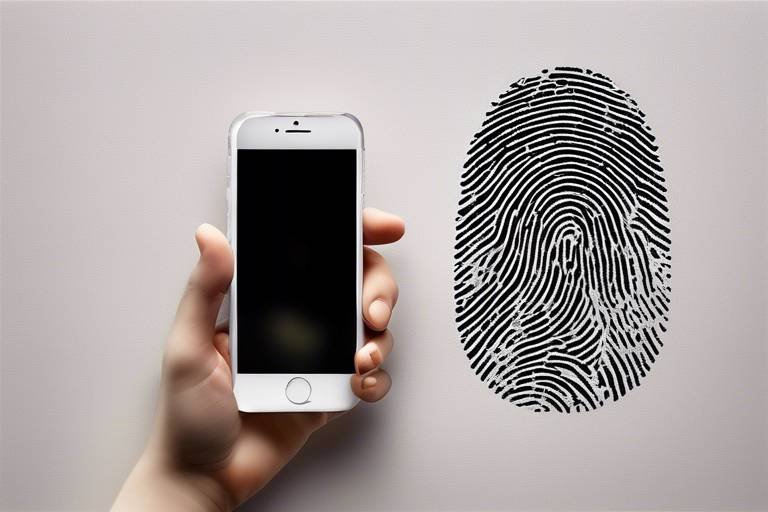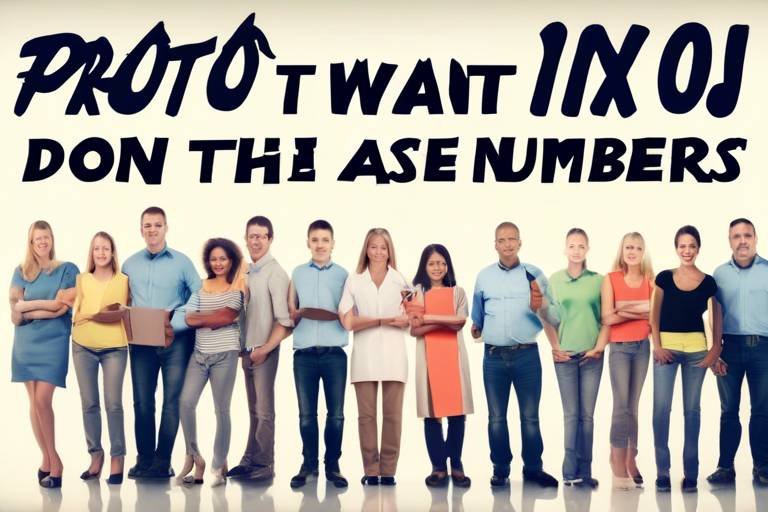Is Fingerprint Identification Safe?
In today's fast-paced digital world, fingerprint identification has become a common method for securing personal devices and sensitive information. But the burning question remains: is fingerprint identification truly safe? As we dive into this topic, we’ll explore the intricacies of this technology, its advantages, potential vulnerabilities, and the implications it has for our privacy and security.
Fingerprint identification operates on the principle that no two fingerprints are alike. This uniqueness is what makes fingerprint technology so appealing for various applications, from unlocking smartphones to securing government facilities. However, while the concept seems straightforward, the underlying technology has evolved significantly over the years, incorporating sophisticated algorithms and machine learning to enhance accuracy. Yet, with this advancement comes the need for a critical examination of its safety and reliability.
One of the primary advantages of fingerprint identification is its accuracy. Unlike traditional passwords or PINs, which can be forgotten or easily guessed, fingerprints are inherently tied to an individual. This biometric method not only ensures that the person using the device is the rightful owner but also provides a level of convenience that users appreciate. Just imagine the ease of simply placing your finger on a scanner instead of typing in a complex password! However, this ease raises questions about how secure this method truly is.
In terms of reliability, fingerprint identification systems have shown remarkable performance across various scenarios. For instance, in law enforcement, fingerprint analysis has been a cornerstone for solving crimes, helping to identify suspects with a high degree of accuracy. However, it’s crucial to consider the potential for false positives and false negatives. A false positive occurs when the system incorrectly identifies an individual as a match, while a false negative happens when an actual match is not recognized. Understanding the frequency of these errors is vital, as they can have serious implications for security measures in critical environments.
Fingerprint identification is not just limited to law enforcement; it has permeated many aspects of our daily lives. From unlocking your phone to gaining access to secure facilities, the applications are vast and varied. However, as we embrace this technology, we must also acknowledge the potential vulnerabilities that come with it. Cybercriminals are constantly finding new ways to exploit weaknesses in security systems, and fingerprint identification is no exception. The possibility of spoofing fingerprints using sophisticated techniques raises alarms about the safety of relying solely on this method for security.
Moreover, the use of fingerprint technology brings forth significant privacy concerns. Storing and sharing biometric data poses risks that many users may not fully understand. Once your fingerprint data is compromised, it can lead to identity theft or unauthorized access to sensitive information. This raises ethical questions about consent and the ownership of biometric data. Are we truly aware of how our data is being used and who has access to it?
To mitigate these risks, implementing robust data security measures is essential. Organizations that utilize fingerprint identification must prioritize the protection of biometric data against unauthorized access. This includes encrypting data, restricting access to authorized personnel only, and regularly updating security protocols. By doing so, they can help ensure that users feel safe and secure when using fingerprint technology.
Lastly, the legal and ethical implications surrounding fingerprint identification cannot be overlooked. Regulations governing biometric data vary by region, and organizations must navigate these complexities carefully. As technology continues to evolve, so too do the ethical dilemmas faced by companies that use fingerprint identification. Striking a balance between security and privacy is a challenge that requires ongoing dialogue and diligence.
- What are the main advantages of fingerprint identification? Fingerprint identification offers high accuracy, speed, and ease of use, making it a popular choice for security applications.
- Can fingerprint identification be easily spoofed? While it is difficult, sophisticated methods can mimic fingerprints, highlighting the need for additional security measures.
- What are the privacy concerns associated with fingerprint data? Storing biometric data poses risks of identity theft and unauthorized access, necessitating stringent data protection practices.
- Are there regulations governing the use of biometric data? Yes, regulations vary by region, and organizations must comply with laws that protect biometric information.

Understanding Fingerprint Technology
Fingerprint identification technology is a fascinating blend of biology and engineering, leveraging the unique patterns found on our fingertips to verify identity. Each person's fingerprints are distinct, formed in the womb, and remain unchanged throughout their life, making them a reliable biometric identifier. The technology has evolved significantly over the years, transitioning from manual methods to sophisticated digital systems that can analyze and match fingerprints with incredible precision.
At its core, fingerprint identification works by capturing an image of a fingerprint using a scanner. This image is then processed to extract key features, such as ridges, valleys, and minutiae points—the tiny details that make each fingerprint unique. The extracted data is converted into a mathematical representation, which is stored in a database. When a fingerprint is presented for verification, the system compares the live scan against the stored data, looking for matches based on the unique characteristics of the fingerprint.
The evolution of fingerprint technology can be traced through several key milestones:
- Early Methods: The earliest forms of fingerprint identification date back to ancient Babylon, where fingerprints were used for business transactions.
- Scientific Development: In the late 19th century, Sir Francis Galton and Edward Henry developed the first scientific methods for classifying fingerprints, laying the groundwork for modern systems.
- Digital Revolution: The introduction of digital fingerprint scanners in the late 20th century allowed for faster and more accurate processing, making the technology more accessible for various applications.
Today, fingerprint identification is used in numerous sectors, from law enforcement to mobile devices, providing a seamless and secure way to authenticate identity. The technology has not only improved in terms of speed and accuracy but has also become more user-friendly, allowing individuals to unlock their smartphones or access secure locations with just a touch of their finger. However, as with any technology, it is essential to understand both its advantages and potential vulnerabilities to ensure effective and safe use.

Advantages of Fingerprint Identification
Fingerprint identification is rapidly becoming a cornerstone in the realm of security technology, and it's not hard to see why. The advantages it offers make it a compelling choice for various applications, from unlocking smartphones to securing sensitive information in corporate environments. One of the most significant benefits is its accuracy. Fingerprints are unique to each individual, which means that the chances of two people having identical fingerprints are virtually nonexistent. This uniqueness provides a high level of confidence when verifying identities.
Moreover, the speed of fingerprint recognition systems is impressive. In just a matter of seconds, a user can gain access to a device or secure area, making it an efficient option compared to traditional methods like passwords or PINs. Imagine trying to remember a complex password while you're in a hurry; with a fingerprint scanner, you simply place your finger, and voilà! You're in.
Another advantage is the ease of use. Most people are familiar with the concept of fingerprint identification, making it user-friendly. There's no need for complicated instructions or lengthy training sessions. This simplicity makes it an attractive option for businesses looking to implement security measures without overwhelming their employees.
Fingerprint identification systems also come with low maintenance costs. Once installed, they require minimal upkeep compared to other security measures, such as surveillance cameras or security personnel. This cost-effectiveness is particularly appealing for small businesses or organizations with tight budgets.
To further illustrate the advantages, here’s a quick breakdown:
| Advantage | Description |
|---|---|
| Accuracy | Unique patterns ensure high confidence in identity verification. |
| Speed | Quick access to secured areas or devices in seconds. |
| Ease of Use | User-friendly technology that requires no special training. |
| Cost-Effectiveness | Low maintenance costs compared to other security systems. |
In addition to these advantages, fingerprint identification also enhances accountability. In environments where security is paramount, such as law enforcement or financial institutions, having a reliable method of tracking who accessed what and when can be invaluable. Each fingerprint scan can be logged, providing a detailed record that can be referenced if needed.
In conclusion, the advantages of fingerprint identification are numerous and compelling. Its accuracy, speed, ease of use, cost-effectiveness, and accountability make it a popular choice for both individuals and organizations. As technology continues to evolve, we can expect to see even more innovative applications of fingerprint identification, further solidifying its place in our security landscape.

Accuracy and Reliability
When it comes to fingerprint identification, one of the most compelling aspects is its . This technology has evolved tremendously over the years, becoming a cornerstone in various security systems. But what exactly makes it so dependable? Well, the unique patterns of ridges and valleys on our fingertips are as distinctive as a snowflake. Each person's fingerprints are different, and even identical twins do not share the same fingerprint patterns. This uniqueness is what allows fingerprint identification to be a powerful tool in confirming identity.
In practical terms, fingerprint recognition systems utilize sophisticated algorithms to analyze these patterns. The technology compares the captured fingerprint against a database of stored fingerprints, looking for matches. The accuracy rate of modern fingerprint scanners can be as high as 99.9%, which is impressive when you consider the vast amounts of data being processed. However, it’s essential to understand that while the technology is highly accurate, it is not infallible. Factors such as skin condition, dirt, or even the angle at which a fingerprint is scanned can affect the results.
Moreover, the reliability of fingerprint identification extends beyond just accuracy. In various scenarios, such as law enforcement or access control, the speed at which a fingerprint is recognized can be crucial. Imagine trying to access your phone or a secure facility in a hurry; the last thing you want is to fumble with a slow recognition process. Fortunately, advancements in technology have led to systems that can identify fingerprints in a matter of seconds, making them not only accurate but also incredibly efficient.
However, to truly appreciate the effectiveness of fingerprint identification, it’s important to consider the occurrences of false positives and false negatives. A false positive occurs when a system incorrectly identifies a fingerprint as a match, while a false negative happens when it fails to recognize a legitimate fingerprint. Although these errors are relatively rare, they can have significant implications, especially in high-security environments. For instance, a false positive could grant unauthorized access, while a false negative could lock a rightful user out. Understanding these potential pitfalls is crucial for anyone considering the implementation of fingerprint technology.
To mitigate these risks, many systems employ multi-factor authentication, combining fingerprint identification with other forms of verification such as PINs or facial recognition. This layered approach enhances security and ensures that even if one method fails, others are in place to protect sensitive information.
In conclusion, while fingerprint identification boasts impressive accuracy and reliability, it is essential to remain aware of its limitations. The technology continues to evolve, promising even greater precision and speed in the future. As we embrace these advancements, the focus must also be on maintaining a balance between security and user convenience.

False Positives and Negatives
When it comes to fingerprint identification, understanding the concepts of false positives and false negatives is crucial. A false positive occurs when the system incorrectly identifies an individual as a match, while a false negative happens when a match is missed, leading to the rejection of a legitimate fingerprint. These errors can greatly impact the effectiveness of security measures in various applications.
Imagine you're trying to unlock your smartphone with your fingerprint. If the device mistakenly recognizes someone else's fingerprint as yours, that's a false positive. This could lead to unauthorized access, putting your personal data at risk. On the other hand, if your phone fails to recognize your fingerprint, that's a false negative. Frustrating, right? You'd be left locked out, unable to access your own device.
Statistically, the rates of these errors can vary based on several factors, including the quality of the fingerprint scanner, the condition of the fingerprint (e.g., dirt, moisture), and the algorithms used for matching. Here's a quick look at some common factors that can influence error rates:
| Factor | Impact on False Positives | Impact on False Negatives |
|---|---|---|
| Scanner Quality | Higher quality scanners reduce false positives | Higher quality scanners reduce false negatives |
| Fingerprint Condition | Dirty or smudged fingerprints can increase false positives | Dirty or smudged fingerprints can increase false negatives |
| Algorithm Effectiveness | Advanced algorithms can minimize both errors | Advanced algorithms can minimize both errors |
It's important to note that while modern fingerprint systems have become increasingly sophisticated, they are not infallible. In high-security environments, even a small percentage of false positives or negatives can lead to significant consequences. Therefore, organizations often implement additional layers of security, such as multi-factor authentication, to mitigate these risks. By combining fingerprint identification with other methods, they can enhance overall security and reduce the likelihood of errors.
In conclusion, while fingerprint identification technology offers many advantages, understanding the implications of false positives and negatives is essential. These errors can affect not only personal convenience but also the broader context of security and privacy. As technology continues to evolve, ongoing improvements in fingerprint recognition systems aim to reduce these inaccuracies, making them more reliable for everyday use.
- What is a false positive in fingerprint identification? A false positive occurs when the system incorrectly identifies a non-matching fingerprint as a match.
- What is a false negative in fingerprint identification? A false negative happens when the system fails to recognize a legitimate fingerprint, denying access to the rightful user.
- How can false positives and negatives affect security? False positives can lead to unauthorized access, while false negatives can lock out legitimate users, both of which can compromise security.
- What measures can be taken to reduce these errors? Using high-quality scanners, ensuring clean fingerprints, and employing advanced algorithms can help minimize false positives and negatives.

Real-World Applications
Fingerprint identification technology has woven itself into the fabric of our daily lives, showcasing its versatility across various sectors. From law enforcement to personal devices, the applications are as diverse as they are impactful. Let's dive into some of the most prominent areas where this technology is making waves.
In the realm of law enforcement, fingerprint identification is a cornerstone of criminal investigations. Police departments worldwide utilize fingerprint databases to match prints found at crime scenes with those of known offenders. This process not only aids in solving crimes but also helps in preventing future offenses, creating a safer community. Imagine a world where a single fingerprint can link a suspect to a crime, potentially saving lives and resources.
On a more personal level, fingerprint technology has revolutionized the way we secure our mobile devices. Most smartphones today come equipped with fingerprint scanners, allowing users to unlock their phones with just a touch. This not only enhances security but also provides a level of convenience that traditional passwords simply cannot match. Picture this: no more fumbling for your password or worrying about someone peeking over your shoulder; your fingerprint is your key!
Moreover, the financial sector has embraced fingerprint identification as a means to bolster security in banking transactions. Many banks now offer biometric authentication methods, allowing customers to authorize transactions using their fingerprints. This development significantly reduces the risk of fraud and identity theft, making banking safer for everyone. Just think about it—your unique fingerprint could be the difference between secure transactions and financial chaos.
Additionally, fingerprint identification is gaining traction in access control systems. Many businesses and organizations are implementing biometric systems to manage employee access to secure areas. By using fingerprint scanners, they can ensure that only authorized personnel can enter sensitive locations, enhancing overall security. This is particularly crucial in industries like healthcare and data management, where confidentiality is paramount.
In the realm of travel, fingerprint identification is also becoming a standard practice. Airports are increasingly using biometric technology to expedite the check-in and boarding processes. Passengers can scan their fingerprints at various checkpoints, significantly reducing wait times and enhancing the overall travel experience. Imagine breezing through security without the hassle of showing your boarding pass repeatedly—it's a game-changer!
As we can see, the real-world applications of fingerprint identification are vast and varied. Each application not only highlights the technology's effectiveness but also underscores its importance in enhancing security and convenience in our lives. Whether it's in law enforcement, personal devices, finance, access control, or travel, fingerprint identification is proving to be a vital tool in our modern world.

Potential Vulnerabilities
While fingerprint identification is widely regarded as a secure method of authentication, it is not without its . One of the primary concerns is the risk of biometric spoofing, where an individual uses fake fingerprints made from materials like silicone or gelatin to bypass security systems. This can be particularly alarming in high-security environments where the stakes are high, such as financial institutions or government facilities. Just imagine someone holding a mold of your fingerprint and gaining access to your secure accounts—it's a thought that sends chills down the spine!
Another significant vulnerability lies in the storage and transmission of biometric data. When fingerprints are scanned and stored in databases, they must be protected with robust encryption. However, if these databases are hacked, the consequences can be dire. Unlike passwords, which can be changed, biometric data is permanent. Once compromised, it can lead to identity theft and unauthorized access that is difficult to rectify.
Additionally, the accuracy of fingerprint recognition systems can be affected by various factors, including environmental conditions and the physical state of the user's fingers. For instance, dirty or wet fingers might not be scanned accurately, leading to false negatives where legitimate users are denied access. On the flip side, the technology can sometimes incorrectly identify an unauthorized user as legitimate, resulting in false positives. These errors can undermine the trust in fingerprint systems, especially in critical applications where security is paramount.
Moreover, as technology advances, so do the methods used by cybercriminals. There are emerging threats such as machine learning algorithms that can analyze and replicate fingerprints from images taken from social media or public places. This kind of technology poses a unique challenge, as it becomes increasingly difficult to ensure that biometric data remains secure and private.
In summary, while fingerprint identification offers many advantages, it is essential to remain vigilant about its vulnerabilities. Organizations must continually adapt and enhance their security measures to combat these risks. As we navigate the digital age, understanding and addressing these vulnerabilities will be crucial in maintaining the integrity of fingerprint identification systems.
- What is biometric spoofing? Biometric spoofing occurs when someone attempts to gain unauthorized access by using fake biometric traits, such as a replica fingerprint.
- Are fingerprints truly unique? Yes, fingerprints are considered unique to each individual. However, there can be similarities between the prints of different people.
- How can I protect my fingerprint data? Protect your fingerprint data by using devices with strong encryption, enabling two-factor authentication, and being cautious about where you share your biometric information.
- What happens if my fingerprint data is stolen? If your fingerprint data is stolen, it can lead to identity theft and unauthorized access to secure systems, which is challenging to resolve since fingerprints cannot be changed.

Privacy Concerns
As we dive deeper into the world of fingerprint identification, one of the most pressing issues that emerges is the associated with this technology. While the convenience of unlocking your phone or accessing secure areas with just a touch is undeniably appealing, it begs the question: what happens to your biometric data once it's collected? Unlike a password, which can be changed, your fingerprints are a permanent part of you. This permanence raises significant concerns about how this sensitive information is stored, shared, and potentially misused.
Many organizations and companies utilize fingerprint data for various purposes, but the lack of transparency surrounding these practices can be alarming. For instance, when you enroll in a fingerprint system, your data is often stored in a database. If this database is compromised, your fingerprints could be stolen, leading to identity theft or unauthorized access to secure systems. This potential for exploitation makes it crucial for users to understand the risks involved.
Furthermore, the implications of storing biometric data extend beyond individual privacy. Governments and corporations may have access to vast amounts of fingerprint data, raising concerns about surveillance and the potential for misuse. Imagine a scenario where your biometric data is used to track your movements or behavior without your consent. It’s a chilling thought, isn’t it?
To illustrate the scope of these privacy concerns, consider the following:
- Data Breaches: High-profile data breaches have shown that even the most secure systems can be vulnerable. The consequences of a breach involving biometric data could be severe, as it cannot be changed like a password.
- Surveillance: The use of fingerprint identification by law enforcement agencies raises questions about surveillance and the extent to which personal data is monitored.
- Informed Consent: Users may not fully understand what they are consenting to when they provide their fingerprints, leading to ethical dilemmas regarding informed consent.
As we navigate this digital age, it’s essential for individuals to be aware of their rights regarding biometric data. Organizations should prioritize transparency, ensuring that users are informed about how their data will be used and protected. Moreover, robust regulations need to be in place to safeguard this sensitive information.
In conclusion, while fingerprint identification offers remarkable benefits, the privacy concerns it raises cannot be ignored. It’s a balancing act between security and privacy, and as technology continues to evolve, so too must our approach to protecting our most personal information.
- What happens to my fingerprint data after it's collected? - Your fingerprint data is typically stored in a secure database, but the specifics depend on the organization collecting it.
- Can my fingerprints be stolen? - Yes, if a database containing your fingerprint data is breached, your fingerprints could potentially be stolen.
- Are there laws protecting my biometric data? - Yes, various laws and regulations govern the use of biometric data, but they can vary significantly by region.
- How can I protect my biometric data? - Be cautious about where you share your fingerprints and choose organizations that prioritize data security and transparency.

Data Security Measures
In today's digital age, where our lives are increasingly intertwined with technology, the security of biometric data, particularly fingerprint information, is a hot topic. With the rise of fingerprint identification systems in smartphones, security checkpoints, and even banking, ensuring the safety of this sensitive information is paramount. So, how can organizations protect this data from unauthorized access and potential breaches? Let's dive into some essential that can help safeguard fingerprint data.
First and foremost, encryption plays a critical role in securing fingerprint data. By converting the data into a coded format, encryption ensures that even if unauthorized parties gain access to the data, they cannot interpret it without the correct decryption key. This is particularly important when transmitting fingerprint data over the internet or storing it in databases. In fact, many organizations implement end-to-end encryption to provide an extra layer of security.
Another effective measure is the use of multi-factor authentication (MFA). This means that even if someone manages to steal a fingerprint, they would still need additional verification methods, such as a password or a one-time code sent to a mobile device, to gain access to sensitive systems. By requiring multiple forms of identification, MFA significantly reduces the risk of unauthorized access.
Moreover, organizations should regularly conduct security audits and vulnerability assessments on their systems. These assessments help identify potential weaknesses in the security infrastructure, allowing organizations to address them proactively. Think of it as a health check for your security measures; just like you wouldn't wait for a serious health issue to see a doctor, you shouldn't wait for a data breach to evaluate your security protocols.
Additionally, it’s crucial to implement strict access controls. This means limiting access to fingerprint data only to those individuals who absolutely need it for their work. By doing so, organizations can minimize the risk of internal breaches and ensure that sensitive information is only handled by trusted personnel. It's akin to having a key to a safe; only those with the right key should be able to access what’s inside.
Finally, educating employees about data security best practices is vital. Training staff on how to recognize phishing attacks, the importance of strong passwords, and safe data handling can significantly enhance an organization's overall security posture. After all, even the most advanced security measures can be compromised if human error is involved.
In summary, protecting fingerprint data requires a multifaceted approach that includes encryption, multi-factor authentication, regular security audits, strict access controls, and employee education. By implementing these measures, organizations can significantly reduce the risk of unauthorized access and ensure that biometric data remains secure.

Legal and Ethical Considerations
When it comes to fingerprint identification, the legal and ethical considerations are as complex as the technology itself. As biometric data is often considered sensitive personal information, the laws governing its collection, storage, and use are evolving rapidly. In many jurisdictions, legislation is being developed to ensure that individuals' rights are protected while also allowing organizations to utilize this technology for security purposes.
The General Data Protection Regulation (GDPR) in the European Union, for example, has set stringent guidelines for the processing of personal data, including biometric information. Under GDPR, organizations must obtain explicit consent from individuals before collecting their fingerprint data. This means that users must be fully informed about how their data will be used and stored, which raises questions about transparency and accountability.
In the United States, the legal landscape varies by state. Some states, like Illinois, have enacted laws that specifically address the collection and use of biometric data. The Illinois Biometric Information Privacy Act (BIPA) requires organizations to obtain informed consent and implement protective measures for biometric data. However, many states lack comprehensive regulations, leading to a patchwork of laws that can create confusion for both consumers and businesses.
Ethically, the use of fingerprint identification also presents dilemmas. For instance, how do we balance the benefits of increased security against the potential for abuse? There are concerns about surveillance and the possibility that biometric data could be used for purposes beyond what individuals have consented to. The idea of a "surveillance state" looms large, where authorities may misuse fingerprint data to track individuals without their knowledge.
Moreover, the potential for discrimination based on biometric data cannot be overlooked. If certain demographics are disproportionately affected by fingerprint identification systems, it raises ethical questions about fairness and equality. This is particularly relevant in law enforcement, where biases in technology can lead to unjust profiling and targeting.
To navigate these legal and ethical waters, organizations employing fingerprint technology must adopt comprehensive policies that prioritize user privacy and data protection. This includes:
- Implementing robust security measures to protect biometric data from breaches.
- Regularly reviewing and updating consent processes to align with evolving regulations.
- Training employees on the ethical implications of using biometric data.
In conclusion, as fingerprint identification technology continues to advance, the legal and ethical considerations surrounding its use must be carefully examined. Organizations must not only comply with existing laws but also strive to establish ethical standards that respect individuals' privacy and rights. The future of fingerprint identification hinges on finding this delicate balance between security and personal freedom.
- What is fingerprint identification? Fingerprint identification is a biometric technology that uses unique patterns in an individual's fingerprints for identification and verification purposes.
- Is fingerprint identification safe? While fingerprint identification is generally considered safe, it is not without risks, including potential vulnerabilities and privacy concerns.
- What are the legal implications of using fingerprint data? The legal implications vary by region, with laws like GDPR in the EU and BIPA in Illinois providing specific guidelines for the use of biometric data.
- How can organizations protect biometric data? Organizations can protect biometric data by implementing strong security measures, obtaining informed consent, and regularly reviewing their data protection policies.
Frequently Asked Questions
- Is fingerprint identification safe?
Yes, fingerprint identification is generally considered safe due to its unique nature. However, like any technology, it has vulnerabilities that can be exploited. It's essential to implement robust security measures to protect biometric data.
- How does fingerprint identification work?
Fingerprint identification works by analyzing the unique patterns and ridges present in an individual's fingerprints. These patterns are captured using sensors and compared against stored data to verify identity.
- What are the advantages of using fingerprint identification?
Fingerprint identification offers several advantages, including high accuracy, quick processing times, and user-friendliness. It's a popular choice for security systems due to its effectiveness in identifying individuals reliably.
- What are false positives and false negatives in fingerprint identification?
False positives occur when the system incorrectly matches a fingerprint to an unauthorized user, while false negatives happen when it fails to recognize an authorized user. Understanding these errors is crucial for improving security measures.
- Where is fingerprint identification used?
Fingerprint identification is utilized in various fields, including law enforcement, mobile devices, banking, and access control systems. Its versatility makes it a valuable tool in everyday life.
- What are the potential vulnerabilities of fingerprint identification?
While fingerprint identification is secure, potential vulnerabilities include the risk of spoofing, data breaches, and unauthorized access to biometric databases. Awareness of these risks is vital for safeguarding personal information.
- How are privacy concerns addressed with fingerprint identification?
Privacy concerns are addressed through strict regulations and best practices for data storage and sharing. Organizations must ensure that biometric data is protected and used responsibly to maintain user trust.
- What data security measures should be implemented?
To protect fingerprint data, organizations should implement encryption, access controls, and regular security audits. These measures help prevent unauthorized access and ensure that biometric information remains secure.
- What legal and ethical considerations are involved?
Legal and ethical considerations include compliance with data protection regulations, informed consent from users, and the potential for misuse of biometric data. Organizations must navigate these issues carefully to uphold ethical standards.



















